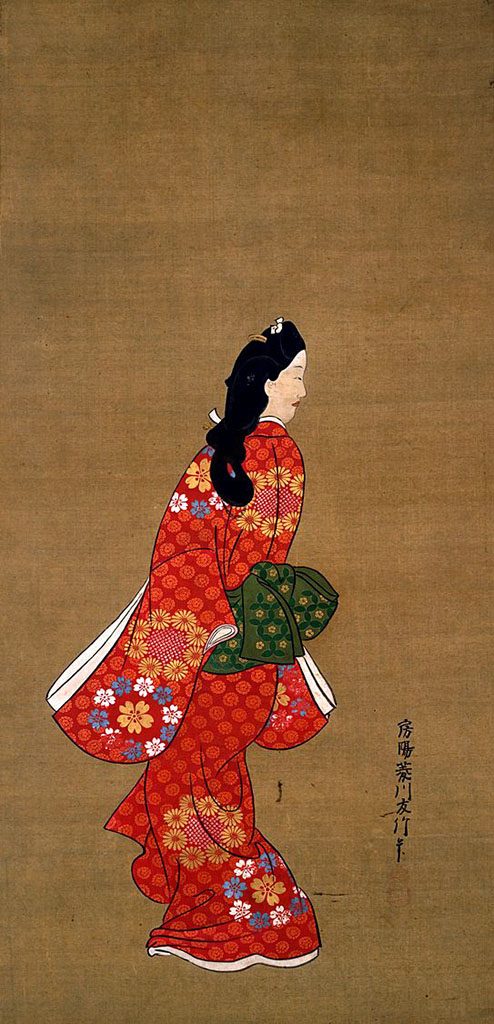
- Hishikawa Moronobu, who turned Ukiyo-e into an art form
- Biography of Hishikawa Moronobu
- Why Hishikawa Moronobu is called “the founder of Ukiyo-e”
- Hishikawa Moronobu’s masterpiece
- Popularity and Features of Hishikawa Moronobu
- Is “Mikaeri Bijinzu” not an Important Cultural Property?
- Evaluation of Hishikawa Moronobu’s influence and reputation
- Summary of Hishikawa Moronobu
Hishikawa Moronobu, who turned Ukiyo-e into an art form
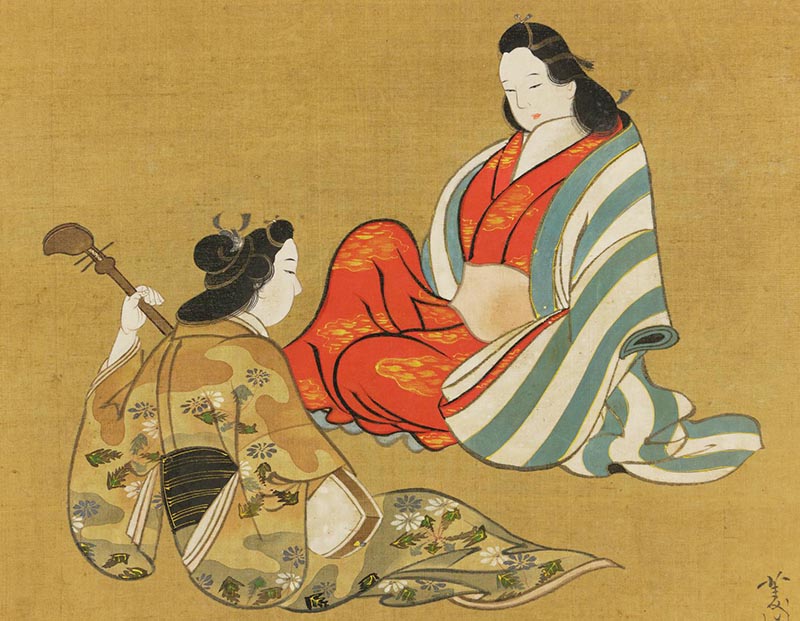
Hishikawa Moronobu was an Ukiyo-e artist active in the Edo period. He is also called “the founder of Ukiyo-e” because he established Ukiyo-e, which had been treated as illustrations until then, as a single work of art to be appreciated by the public.
Moronobu depicted the lives of people in Edo with vivid colors and unique compositions. His Bijin-ga dressed in beautiful and fashionable kimonos became very popular in Edo.
Hishikawa Moronobu’s outstanding works on original drawings and paintings on folding screens had a great influence on later Ukiyo-e artists such as Katsushika Hokusai and Utagawa Hiroshige.
Biography of Hishikawa Moronobu

Born in the town of Kyonan, Chiba Prefecture, Hishikawa Moronobu became familiar with painting at an early age. When he left for Edo at the age of 16, he learned the techniques of the Kano, Tosa, and Hasegawa schools.
Moronobu worked in Edo as a woodblock engraver who drew the original illustrations for woodblock prints, and produced illustrations and pictures of famous places using only black ink rubbings. He emerged as a master woodblock printer, and produced illustrations for various genres such as “Yoshitsune-ki” and “Koshoku Ichidai Otoko”, Genji Yamato-ekagami, Yamato samurai pictures, and Meisho-ki, and established the Moronobu style in which pictures were used more than text.
As Moronobu’s workload increased, his popularity among the public grew, and he developed Ukiyo-e into an art form that could be appreciated as a single picture, thereby enhancing its value as a print art. He also left behind many original drawings (Bijin-ga, Fuzoku-ga, and so on).
Moronobu died in 1694. His Ukiyo-e techniques were passed down to future generations through his workshop and his pupils.
Why Hishikawa Moronobu is called “the founder of Ukiyo-e”

If “Iwasa Matabe” was the founder of Ukiyo-e, then “Hishikawa Moronobu” was the one who made Ukiyo-e into an art form of single-page prints and popularized it among the general public through mass production using woodblock printing.
Moronobu transformed Ukiyo-e, which had been only illustrations for books, into a single sheet of woodblock prints and conveyed its appeal to the people of Edo. When Ukiyo-e could be mass-produced inexpensively using woodblock printing, it became more affordable for people in Edo, who previously could not afford to buy them, and became a part of popular culture.
Hishikawa Moronobu’s masterpiece
Hishikawa Moronobu “Mikaeri Bijinzu”

The most famous Ukiyo-e of Hishikawa Moronobu’s works and considered a masterpiece of his later years is “Mikaeri Bijinzu” (Beauty looking back).
In “Mikaeri Bijinzu”, Moronobu depicts a beautiful woman in a bright furisode kimono looking backward, and the model is said to be an Edo town girl.
The beauty looking back is dressed in the latest fashion, with her hair tied in a bead knot, her kimono in the then-fashionable floral circle with cherry blossoms and chrysanthemums, and her obi also in the then-fashionable Kichiya knot. Moronobu’s paintings of beautiful women were well received in Edo at the time, and his “Mikaeri Bijinzu” was also popular.
“Mikaeri Bijinzu” is also known for being used as the design for the first commemorative postwar stamp.
Hishikawa Moronobu “Kabuki Zu Byobu”

Along with “Mikaeri Bijinzu”, “Kabuki Zu Byobu” (Kabuki Theater) is one of Hishikawa Moronobu’s most famous works.
“Kabuki Zu Byobu” is a painting of folding screen depicting scenes from the Nakamura-za Theater in Edo. The Kabuki stage, dressing rooms, and audience seating are vividly depicted. The “Kabuki Zu Byobu” depicts a total of 285 characters, including backstage workers and actors preparing for their performance in their dressing rooms, which are not usually seen in the public eye. The screen shows how Edo’s entertainment had matured as a cultural form.
“Kabuki Zu Byobu” is designated as a National Important Cultural Property.
Hishikawa Moronobu “Edo Fuzoku Zu Byobu”
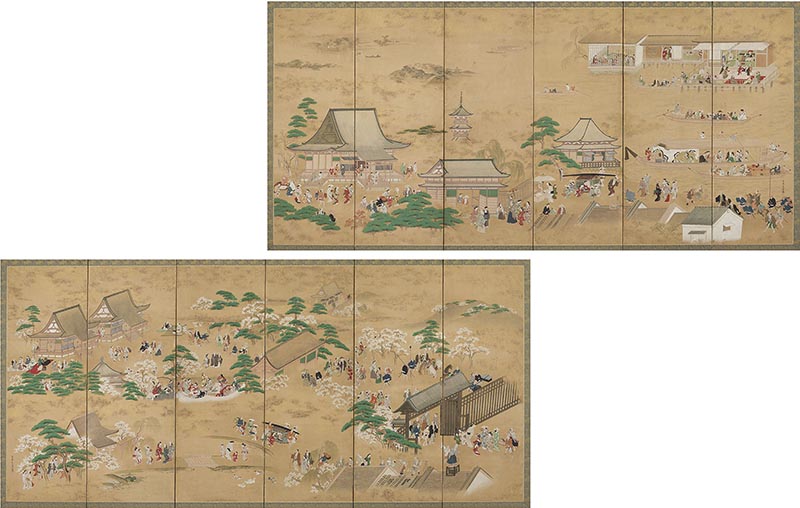
Hishikawa Moronobu’s “Edo Fuzoku Zu Byobu” (Viewing Cherry Blossoms at Ueno Park and Autumn at Asakusa) is a painting of folding screen depicting scenes of Edo in spring and autumn. It vividly depicts the life and customs of Edo, including people visiting Senso-ji Temple in the fall and people viewing cherry blossoms at Kan-eiji Temple in Ueno in the spring.
“Edo Fuzoku Zu Byobu” is currently housed at the Freer Gallery of Art in Washington, DC, USA.
Popularity and Features of Hishikawa Moronobu
Inexpensive woodblock prints popularized Ukiyo-e
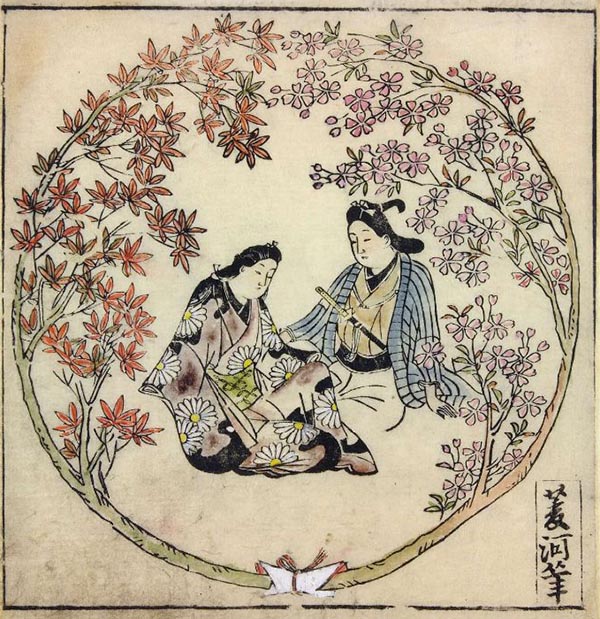
Ukiyo-e by Hishikawa Moronobu, which had transformed from picture books to single pictures for viewing, were printed in black ink with rare coloring. Ukiyo-e woodblock prints, which could be printed in large quantities, were inexpensive and easily accessible to the general public, and helped develop the Ukiyo-e culture in Edo.
People of Edo vividly and colorfully depicted

Hishikawa Moronobu also left many outstanding works of art in the form of hanging scrolls, paintings of folding screens, and other hand paintings. His vividly colored paintings depict scenes of Edo life and Kabuki theater, sometimes humorously, sometimes joyfully. The people in his genre paintings are characterized by the finely detailed and delicate depiction of their facial expressions and even the patterns of their kimonos.
The latest fashionable and beautiful paintings
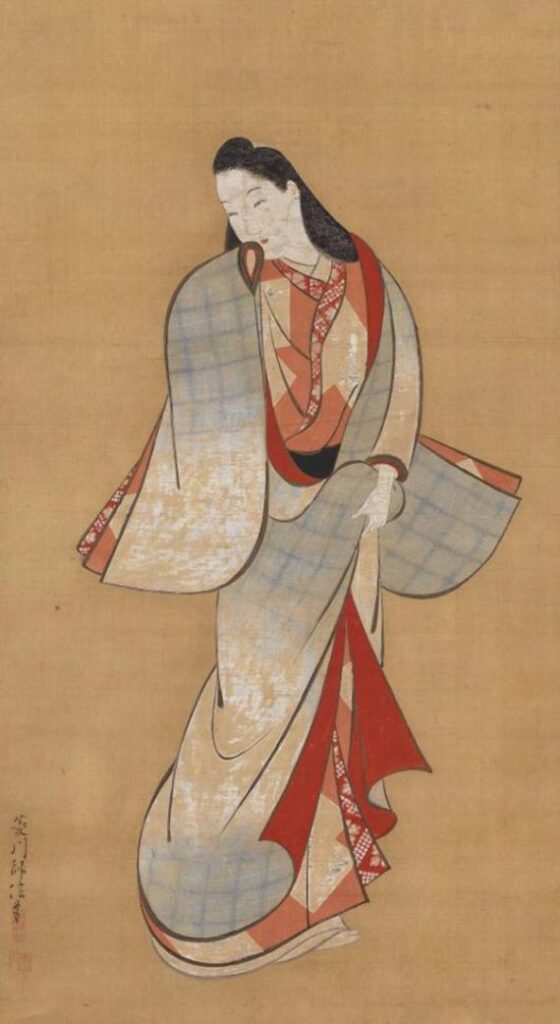
Hishikawa Moronobu also left behind many paintings of beautiful women, including his masterpiece “Mikaeri Bijinzu”. His paintings of beautiful women, painted with his own hand, are dressed like fashion models of today, with their trendy hairstyles and glamorous kimonos. His paintings became so popular that they were known in Edo as “Moronobu’s beauties are exactly Edo women”.
Is “Mikaeri Bijinzu” not an Important Cultural Property?
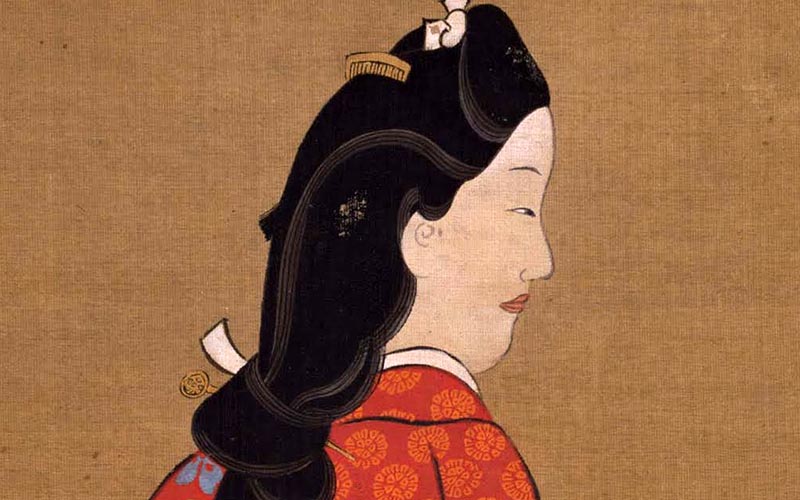
Hishikawa Moronobu’s “Mikaeri Bijinzu” is not designated as a National Important Cultural Property. This may come as a surprise to some.
Reasons for not being designated as Important Cultural Properties
Some people say that Hishikawa Moronobu is not an important historical figure. However, considering that his “Kabuki Zu Byobu” is designated as an Important Cultural Property, it does not seem that there is anything wrong with the historical antiquity of the work or with himself.
Some people also say that the “Mikaeri Bijinzu” is not beautiful, or that it is not a beautiful woman. However, the fact that “Mikaeri Bijinzu” was a reputable painting of beautiful women in Edo means that it was a “beauty” according to the value of that era. And if beauty is the criterion for evaluation, there are works among the Important Cultural Properties that have already been designated as such that are not “beauties” (to put it another way, there is Tetsugoro Mantetsu’s “Ratai Bijin” (Nude Beauties), for example).
Why is “Mikaeri Bijinzu” not designated as an Important Cultural Property? To be honest, the reason is a “mystery” even to me, the author.
May be designated as an important cultural property
“Mikaeri Bijinzu”, owned by the Tokyo National Museum, is a symbol of the Tokyo National Museum, which attracts large crowds every time it is exhibited. In the past, woodblock prints of Ukiyo-e have also been designated as Important Cultural Properties. “Mikaeri Bijinzu”, a original painting Ukiyo-e, is considered a work that could become an Important Cultural Property in the future.
Evaluation of Hishikawa Moronobu’s influence and reputation
Hishikawa Moronobu’s reputation in Japan
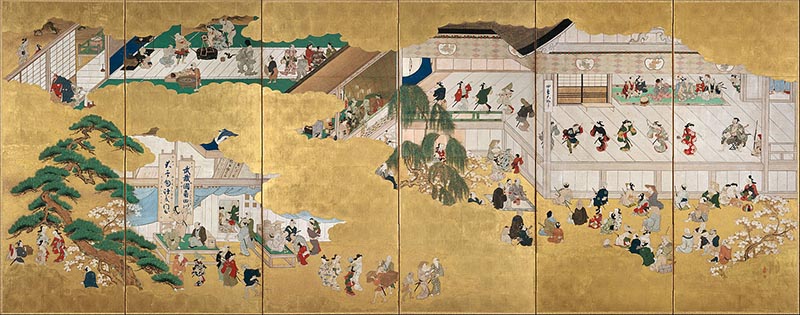
Hishikawa Moronobu is the founder of Ukiyo-e and has influenced many Ukiyo-e artists.
In modern Japan, he is so well known for his “Mikaeri Bijinzu” that it is said that “Hishikawa Moronobu = Mikaeri Bijinzu”, and in the past, he collaborated with very popular characters such as BE@RBRICK and Hatsune Miku on “Mikaeri Bijinzu”.
In Kyonan Town, Chiba Prefecture, Moronobu’s birthplace, there is a public art museum, the Hishikawa Moronobu Memorial Museum, which introduces his life and works.
Hishikawa Moronobu’s reputation abroad
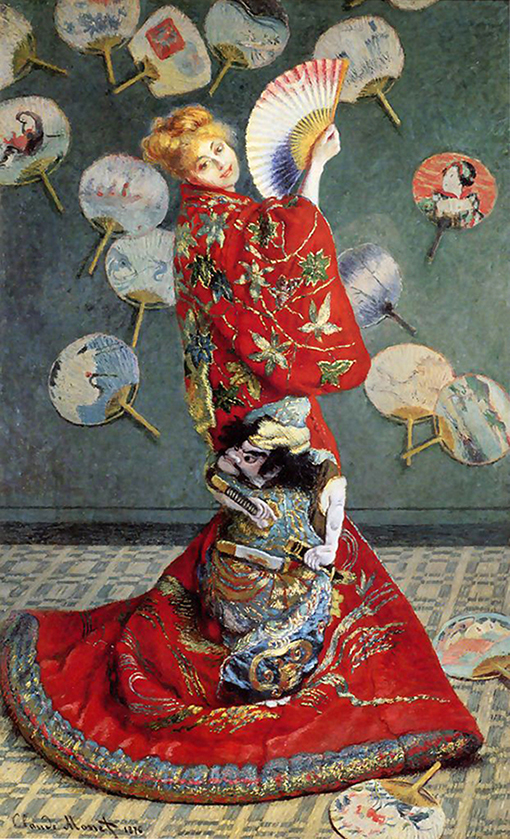
Hishikawa Moronobu is not well known abroad, except among some art critics and Ukiyo-e collectors. It may be safe to say that he is classified as a minor Ukiyo-e artist compared to famous Ukiyo-e artists such as Katsushika Hokusai and Utagawa Hiroshige.
In France, Japonisme was very popular in the latter half of the 19th century, and French Impressionist painters were inspired by Ukiyo-e works. In “La Japonaise” by Claude Monet, a master of French Impressionism, the pose of his wife Camille looking back is reminiscent of “Mikaeri Bijinzu”.
Although Moronobu was not well known in the general public, his artistic quality was appreciated by art critics, Ukiyo-e collectors, and impressionist painters.
Summary of Hishikawa Moronobu
Hishikawa Moronobu developed Ukiyo-e from book illustrations to single pictures, and spread it to Edo through mass production using woodblock printing.
If Ukiyo-e had been an art form that could not be mass-produced, it would not have spread to the common people of Edo, and the Japonisme movement might not have taken off in France. Hishikawa Moronobu did a great deal of work in popularizing Ukiyo-e, and he was truly worthy of being called “the founder of Ukiyo-e”.


